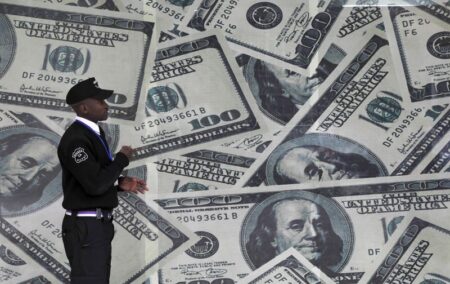By Karen Brettell
NEW YORK (Reuters) -The dollar dropped against the euro and yen on Monday as investors continued to digest last week’s mixed U.S. economic data and looked ahead to a key inflation reading for fresh clues on when the Federal Reserve is likely to begin cutting interest rates.
The greenback initially bounced on Friday after data showed that U.S. employers hired 216,000 workers in December, above economists’ expectations in a Reuters poll, while average hourly earnings rose 0.4%, which was also above expectations.
The U.S. currency then dropped, however, as investors focused on some underlying factors in the jobs report that showed less strength. It declined further after a separate report showed the U.S. services sector slowed considerably in December, with a measure of employment dropping to the lowest level in nearly 3-1/2 years.
“Friday’s nonfarm payroll data was kind of a mixed bag. The headline number was definitely quite high and good, but there were a lot of subsets to that data point that showed some larger weakness in the labor market as well,” said Helen Given, FX trader at Monex USA in Washington.
“There are definitely cracks slowing down the pace of labor hiring in the U.S. and the labor market is definitely loosening,” she added.
The release on Thursday of the consumer price inflation report for December will be the main piece of economic data this week. It is expected to show headline inflation rose 0.2% in the month and by 3.2% on an annual basis.
A New York Fed report on Monday showed that U.S. consumers’ projection of inflation over the short run fell to the lowest level in nearly three years in December.
A drop in inflation closer to the Fed’s 2% annual target would make it more likely that the U.S. central bank will cut rates in the coming months.
Fed funds futures traders are pricing in rate cuts beginning in March, though the odds of a move that soon have fallen. Traders now see a 64% chance of a rate reduction in March, down from 89% a week ago, according to CME Group’s (NASDAQ:) FedWatch Tool.
Some analysts see the Fed as most likely to make its first cut in order to avoid the gap between the federal funds rate and inflation widening too far, as such a scenario would tighten economic conditions more than policymakers intend.
Atlanta Fed President Raphael Bostic said on Monday that with inflation still above the central bank’s target, his bias is for monetary policy to remain tight even though overall risks in the economy have become balanced between those posed by rising prices and those posed by slower employment growth.
RATE-CUT EXPECTATIONS
The was last down 0.23% at 102.21, after gaining 1% last week, the most in six months.
The index hit a five-month low of 100.61 on Dec. 28. But with other major central banks including the European Central Bank and Bank of England also expected to cut rates this year, some analysts see significant further weakness in the U.S. currency as unlikely this year.
The euro rose 0.19% to $1.09595. The greenback fell 0.35% to 144.10 Japanese yen.
The Bank of Japan (BOJ) is expected to be an outlier this year by lifting rates out of negative territory, though interest rates in the country are likely to remain below those of its global peers.
The timing of any hike may also be pushed back after Japan last week suffered a 7.6 magnitude earthquake in the western Noto peninsula.
“The earthquake aftermath can push back speculation of a BOJ policy tweak later this month,” John Briggs, global head of economics and markets strategy at NatWest Markets, noted in a report on Monday.
In cryptocurrencies, bitcoin jumped 7.1% to$47,065, the highest level since April 2022. The U.S. Securities and Exchange Commission is due to decide whether to approve bitcoin exchange-traded funds.
Read the full article here











